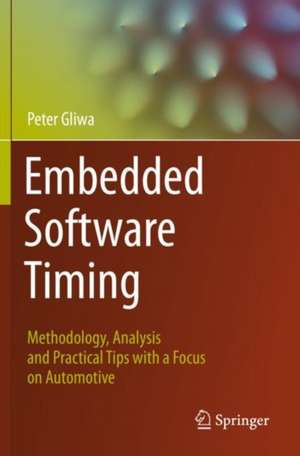Embedded Software Timing: Methodology, Analysis and Practical Tips with a Focus on Automotive
Autor Peter Gliwaen Limba Engleză Paperback – 10 feb 2022
The number of embedded systems that we encounter in everyday life is growing steadily. At the same time, the complexity of the software is constantly increasing. This book is mainly written for software developers and project leaders in industry. It is enriched by many practical examples mostly from the automotive domain, yet the vast majority of the book is relevant for any embedded software project. This way it is also well-suited as a textbook for academic courses with a strong practical emphasis, e.g. at applied sciences universities.
Features and Benefits
* Shows how to consider timing in the development process for embedded systems, how to solve timing problems, and how to address timing verification
* Enriched by many practical examples mostly from the automotive domain
* Mainly written for software developers and project leaders in industry
| Toate formatele și edițiile | Preț | Express |
|---|---|---|
| Paperback (1) | 390.46 lei 43-57 zile | |
| Springer International Publishing – 10 feb 2022 | 390.46 lei 43-57 zile | |
| Hardback (1) | 653.06 lei 43-57 zile | |
| Springer International Publishing – 10 feb 2021 | 653.06 lei 43-57 zile |
Preț: 390.46 lei
Preț vechi: 488.08 lei
-20% Nou
Puncte Express: 586
Preț estimativ în valută:
74.72€ • 78.21$ • 62.19£
74.72€ • 78.21$ • 62.19£
Carte tipărită la comandă
Livrare economică 31 martie-14 aprilie
Preluare comenzi: 021 569.72.76
Specificații
ISBN-13: 9783030641467
ISBN-10: 3030641465
Ilustrații: XI, 305 p. 116 illus., 10 illus. in color.
Dimensiuni: 155 x 235 mm
Greutate: 0.45 kg
Ediția:1st ed. 2021
Editura: Springer International Publishing
Colecția Springer
Locul publicării:Cham, Switzerland
ISBN-10: 3030641465
Ilustrații: XI, 305 p. 116 illus., 10 illus. in color.
Dimensiuni: 155 x 235 mm
Greutate: 0.45 kg
Ediția:1st ed. 2021
Editura: Springer International Publishing
Colecția Springer
Locul publicării:Cham, Switzerland
Cuprins
1. General Basics.- 2. Microprocessor Technology Basics.- 3. Operating Systems.- 4. Timing Theory.- 5. Timing Analysis Techniques.- 6. Practical Examples of Timing Problems.- 7. Multi-Core, Many-Core, and Multi-ECU Timing.- 8. Timing Optimization.- 9. Methodology During the Development Process.- 10. AUTOSAR.- 11. Safety and ISO 26262.- 12. Outlook.
Notă biografică
Peter Gliwa has been working with automotive operating systems and timing for over 20 years and advises international suppliers and car manufacturers on these topics. He was a lecturer for microcomputer technology at the Baden-Wuerttemberg Cooperative State University in Stuttgart, Germany, for several years and regularly holds training courses.
Textul de pe ultima copertă
Without correct timing, there is no safe and reliable embedded software. This book shows how to consider timing early in the development process for embedded systems, how to solve acute timing problems, how to perform timing optimization, and how to address the aspect of timing verification.
The book is organized in twelve chapters. The first three cover various basics of microprocessor technologies and the operating systems used therein. The next four chapters cover timing problems both in theory and practice, covering also various timing analysis techniques as well as special issues like multi- and many-core timing. Chapter 8 deals with aspects of timing optimization, followed by chapter 9 that highlights various methodological issues of the actual development process. Chapter 10 presents timing analysis in AUTOSAR in detail, while chapter 11 focuses on safety aspects and timing verification. Finally, chapter 12 provides an outlook on upcoming and future developments in software timing.
The number of embedded systems that we encounter in everyday life is growing steadily. At the same time, the complexity of the software is constantly increasing. This book is mainly written for software developers and project leaders in industry. It is enriched by many practical examples mostly from the automotive domain, yet the vast majority of the book is relevant for any embedded software project. This way it is also well-suited as a textbook for academic courses with a strong practical emphasis, e.g. at applied sciences universities.
Features and Benefits
* Shows how to consider timing in the development process for embedded systems, how to solve timing problems, and how to address timing verification * Enriched by many practical examples mostly from the automotive domain
* Mainly written for software developers and project leaders in industry
Features and Benefits
* Shows how to consider timing in the development process for embedded systems, how to solve timing problems, and how to address timing verification * Enriched by many practical examples mostly from the automotive domain
* Mainly written for software developers and project leaders in industry
Caracteristici
Shows how to consider timing in the development process for embedded systems, how to solve timing problems, and how to address timing verification Enriched by many practical examples mostly from the automotive domain Mainly written for software developers and project leaders in industry
